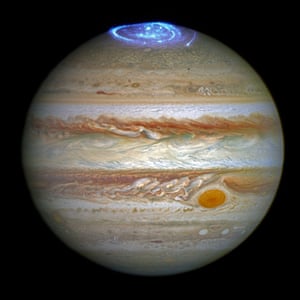'Welcome to Jupiter': Nasa mission puts Juno in orbit after five-year journey
After a five-year
voyage across 1.8bn miles (2.8bn km), Nasa’s
Juno spacecraft has reached Jupiter and successfully entered its
orbit. Braving intense
radiation and a field of space rocks, the probe inched into the orbit of the
largest planet in the solar system at 03.18 GMT.
The manoeuvre was
extremely complex, with the craft first having to slow down and then turn off
its engines to enter Jupiter’s orbit at exactly the right moment.
Hello Jupiter!
The 35-minute engine burn, which began at
11:18 p.m. EST, slowed Juno by 1,212 mph, so it could be captured by the
planet’s gravitational pull. Juno was traveling 130,000 mph
Juno’s success
prompted joy at Nasa’s jet propulsion laboratory, where team members had been
watching the probe’s progress with bated breath. “Juno, welcome to Jupiter,” said mission
control commentator Jennifer Delavan of Lockheed Martin, which built Juno. In
the background, scientists could be seen cheering, clapping and hugging each
other.
Speaking at a press
conference shortly later, Diane Brown, Juno’s project manager, said “It’s
overwhelming.” “The risks that were
overcome, it’s amazing. The more you know about the mission the more you know
about how tricky it was.” “To know we can go to
bed tonight not worrying about what is going to happen tomorrow, is just
amazing,” she said.

An aurora at Jupiter’s north pole glows a luminous blue.
Photograph: NASA/ESA/PA
Juno’s
mission is to peer through Jupiter’s cloud-socked atmosphere and map
the interior from a unique vantage point above the poles. Among the lingering
questions: How much water exists? Is there a solid core? Why are Jupiter’s
southern and northern lights the brightest in the solar system? “What Juno’s about is
looking beneath that surface,” Bolton said before the craft’s arrival. “We’ve
got to go down and look at what’s inside, see how it’s built, how deep these
features go, learn about its real secrets.”
The fifth rock from
the sun and the heftiest planet in the solar system, Jupiter is what’s known as
a gas giant — a ball of hydrogen and helium — unlike rocky Earth and Mars.
Bristling with
instruments, Juno will peer deep beneath Jupiter’s clouds to learn how the
planet formed; what drives its brilliant aurorae; and how its complex weather
systems produce the giant
red spot and the swirling, enigmatic stripes that decorate its outer
layers.
The planet formed from an enormous gas
cloud 4.5bn years ago under the feeble light of the newborn sun. The material
leftover became the rest of the planets, the asteroids and the comets. All
would fit easily within the bulk of Jupiter, a planet 11 times wider than Earth
and 300 times more massive… Read more:
